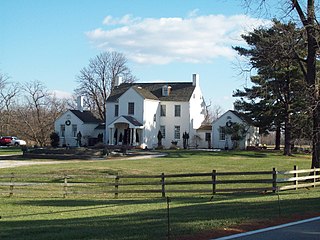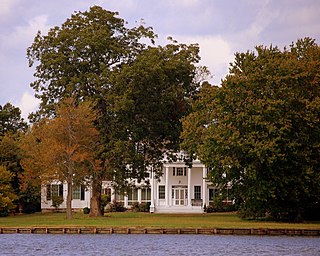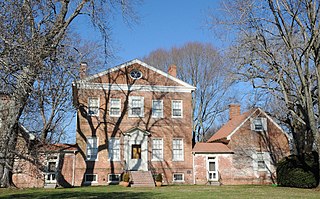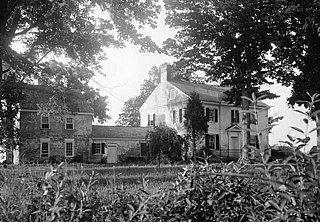
The Hammond–Harwood House is a historic house museum at 19 Maryland Avenue in Annapolis, Maryland, USA. Built in 1774, is one of the premier colonial houses remaining in America from the British colonial period (1607–1776). It is the only existing work of colonial academic architecture that was principally designed from a plate in Andrea Palladio's I Quattro Libri dell'Architettura (1570). The house was designed by the architect William Buckland in 1773–1774 for wealthy farmer Matthias Hammond of Anne Arundel County, Maryland. It was modeled on the design of the Villa Pisani in Montagnana, Italy, as depicted in Book II, Chapter XIV of Palladio's work. It was designated a National Historic Landmark in 1960, and is now managed by a non-profit organization as a museum.

Wye House is a historic residence and former headquarters of a historic plantation house northwest of Easton in rural Talbot County, Maryland. Built in 1781–1784, it is a high-quality and well-proportioned example of a wooden-frame Southern plantation house. It was designated a National Historic Landmark in 1970.

The William Paca House is an 18th-century Georgian mansion in Annapolis, Maryland, United States. Founding Father William Paca was a signatory of the Declaration of Independence and a three-term Governor of Maryland. The house was built between 1763 and 1765 and its architecture was largely designed by Paca himself. The 2-acre (8,100 m2) walled garden, which includes a two-story summer house, has been restored to its original state.

The Brice House is, along with the Hammond-Harwood House and the William Paca House, one of three similar preserved 18th century Georgian style brick houses in Annapolis, Maryland. Like the Paca and Hammond-Harwood houses, it is a five-part brick mansion with a large central block and flanking pavilions with connecting hyphens. Of the three, the Brice House's exterior is the most austere, giving its brickwork particular prominence. The Brice House was declared a National Historic Landmark in 1970.

Whitehall is a colonial home that was built beginning in 1764 near Annapolis in Anne Arundel County in the Province of Maryland by Horatio Sharpe, then the provincial governor of the British colony of Maryland.

Tulip Hill is a plantation house located about one mile from Galesville in Anne Arundel County in the Province of Maryland. Built between 1755 and 1756, it is a particularly fine example of an early Georgian mansion, and was designated a National Historic Landmark in 1970 for its architecture.

Riversdale, is a five-part, large-scale late Georgian mansion with superior Federal interior, built between 1801 and 1807. Also known as Baltimore House, Calvert Mansion or Riversdale Mansion, it is located at 4811 Riverdale Road in Riverdale Park, Maryland, and is open to the public as a museum.

Pleasant Prospect is a historic home located at Mitchellville, Prince George's County, Maryland. It is an outstanding and important example of a Federal style plantation house, consisting of a 2½-story main structure over a full basement with a 2-story kitchen linked by a 1-story hyphen. The kitchen wing and hyphen are typical of late eighteenth century ancillary architecture in Southern Maryland. The walls are laid in Flemish bond, and the chimneys are typical of Maryland; wide on the side, thin and high above the ridge, rising on the gable ends of the house flush with the building wall. The interior exhibits outstanding Federal style trim, including elaborate Adamesque moldings and plasterwork ornamentation such as garlands, swags, and urns applied to interior doorways and mantles. A pyramidal roof, log meat house stands on the immediate grounds.

The Sandy Point Farmhouse is a historic home at Sandy Point State Park, Anne Arundel County, Maryland, United States. It is a five-part plan consisting of a two-story central block connected to two wings by single-story hyphens. It was built in an 18th-century style in the 19th century and typical of Maryland domestic architecture. The house was constructed about 1815 for John Gibson, a member of the Annapolis elite and a relative of Samuel Ogle, an 18th-century Governor of Maryland.

The Anchorage is a historic home in Easton, Talbot County, Maryland, USA. It is a five-part house with a large 2+1⁄2-story center section and small hyphens and wings. It has a 2-story Greek Revival porch supported by four Doric columns. The main section was built around 1810, with the wings probably added during the 1830s. Also on the property is a log smokehouse and a windmill. The Lloyd family of Wye House bought the property in 1831 and one of Governor Edward Lloyd's daughters and her husband went to live in it.
Clay's Hope is a historic home in Bellevue, Talbot County, Maryland, United States. It is a 2+1⁄2-story, 3-bay Flemish bond brick house with the gable roof, built around 1783. Also standing on the property is an array of outbuildings including the last known tobacco house to survive in Talbot County; a frame structure built around 1800. Other structures include a smokehouse-like frame structure built as an implement storage building and an early-19th-century gable-roofed structure with built-in seats that has been converted into a gazebo. A small Harrison family cemetery is also on the property.
Crooked Intention is a historic home in St. Michaels, Talbot County, Maryland, United States. It is a 1+1⁄2-story brick dwelling, three bays wide with wings, built about 1753. A 1+1⁄2-story Flemish bond wing was added in 1956. Also on the property is the original brick smokehouse and a beaded clapboard dairy.
The Wye Town Farm House is a historic home in Easton, Talbot County, Maryland, United States. It is of brick construction, one and one-half stories high and two rooms deep with a small one-story brick kitchen. A two-story addition was made in the 20th century. The original section of the house dates from about 1800.

Troth's Fortune, also known as Troth's Farm, is a historic home in Easton, Talbot County, Maryland, United States. It is a 1+1⁄2-story, two-room deep, gambrel-roofed dwelling with a medieval style stair tower and a richly detailed interior. The house has two 20th century frame wings. It was probably built between the years 1686 and 1710, and is a well-preserved example of late 17th century Maryland vernacular architecture.

Old Bloomfield is a historic home at Easton, Talbot County, Maryland, United States. It is a large and sprawling structure constructed in three major sections: a 1+1⁄2-story, three bay brick section with a steeply pitched roof built about 1720; a 1+1⁄2-story frame addition on the southwest gable built about 1840; and a 2-story frame wing on the southwest end of this earlier addition. Also on the property is a small frame dairy, a heavy timber-frame crib, and a barn. It has remained in the same family as a working farm continuously since the 17th century.

Greenfields is a historic home located at Cecilton, Cecil County, Maryland, United States. It is a 2+1⁄2-story, Georgian-style brick dwelling with a hip roof, built about 1770. The home features a central door with engaged Doric columns and a fanlight in a one-bay pedimented pavilion. It was home to Governor Thomas Ward Veazey and John Ward, Colonel of the Provincial Militia of Cecil County (1756).

Readbourne is a historic home on the Chester River located at Centreville, Queen Anne's County, Maryland, United States. It is a five-part Georgian brick house: the center block was built in the early 1730s; the south wing in 1791; and the north wing in 1948. The central part of the house is the most significant, being a "T"-shaped, two-story brick building with a hip roof, measuring 60 feet (18 m) by 23 feet 6 inches (7.16 m). All of the brick walls are laid in Flemish bond.

Kennersley is a historic home located at Church Hill, Queen Anne's County, Maryland. It is a large five-part brick house believed to date to the last quarter of the 18th century. The central block is approximately 35 feet square, two and a half stories high, with the pitched gable roof. Flanking one-story hyphens connect the central block with a pair of flanking 1+1⁄2-story wings. The house was constructed between 1785 and 1798.

Kingston Hall is a historic home located at Kingston, Somerset County, Maryland. Located along the Big Annemessex River, it is a Georgian style dwelling of two stories plus an attic, three bays wide by two deep, connected by a one-story brick hyphen to a two-story-plus-loft brick kitchen wing. Also on the property is the brick, circular ice house. The interior of the house features corner fireplaces. Interior woodwork mouldings are in a transitional style, bridging late Georgian and Federal styles.

The Easton Historic District is a historic district that covers most of the core of the town of Easton, Maryland. The town is the county seat of Talbot County. The state of Maryland is nearly split by the Chesapeake Bay, and Easton is located on the east side of the bay that is known as Maryland's Eastern Shore. Although the town is part of the east coast of the United States, the region's history goes back to a time when Maryland was a colonial province of England.





















